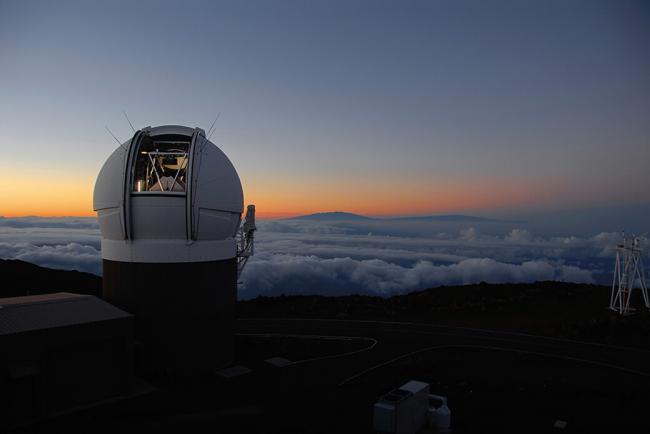Pan-STARRS-1 Science Consortium
Many objects in the sky don’t change or move visibly on human time scales. However, many others do, especially objects in the Solar System. The Panoramic Survey Telescope and Rapid Response System (Pan-STARRS) program is designed to monitor the sky for transient astronomical phenomena: everything from near-Earth asteroids to supernovas in far-off galaxies. The first phase of the program, Pan-STARRS1, used a 1.8-meter telescope on the summit of Haleakalā on the island of Maui in Hawaii. The Center for Astrophysics | Harvard & Smithsonian is part of the international Pan-STARRS1 Science consortium, along with the University of Hawaii and other institutions around the world. Pan-STARRS1 data revealed many asteroids, comets, and other previously-unknown moving or variable astronomical objects.

The Pan-STARRS1 Telescope is located on Halealakalā in Maui, Hawaii. The dome of the observatory is seen standing open at sunset to prepare for a night of observations.
The Telescope and the Science
From ancient times, humans have watched for changes in the sky. Modern astronomers may not be looking for omens, but they still monitor things that move or change in brightness, including asteroids and comets that might pose a threat to Earth at some point in the far future. Less urgently, but no less important scientifically, tracking changes in the sky can reveal new objects in the outer Solar System, variable stars, or transient events like supernovas.
Spotting transient events requires vigilance, which is the value of the Pan-STARRS program. The 1.8-meter Pan-STARRS1 Telescope (PS1) was built with the world’s largest astronomical camera, with nearly 1.4 billion pixels. This camera takes four exposures of a given patch of the night sky in an hour, comparing the four images automatically to identify anything that had changed during the time. Nearly anything changing that quickly is likely a near-Earth object (NEO): asteroid or other small Solar system body close to Earth. Pan-STARRS1 is responsible for the identification of over half of NEOs larger than 140 meters in size, and most newly-discovered comets.
CfA researchers use PS1 data to look for new objects in the outer Solar System: the small worlds of the Kuiper Belt, comets, moons, and the icy asteroids called “centaurs” that reside among the giant planets. These small objects are relics of the early days of the Solar System, and their orbits reveal how the planets and other worlds interact to create the trajectories we observe today.
Pan-STARRS1 operated from 2008 to 2014. The Pan-STARRS2 project began in 2013, with a second 1.8-meter telescope added to the first for an even greater ability to monitor the sky for changes.
- How do stars and planets form and evolve?
- Why do galaxies differ so much in size, shape, composition and activity?
- What is the universe made of?
- Quasars & Other Active Black Holes
- Astrostatistics
- Dark Energy and Dark Matter
- Galaxy Formation and Evolution
- Large Scale Structure
- Cosmology
- The Energetic Universe
- Stellar Astronomy
- The Milky Way Galaxy
- Extragalactic Astronomy
- Computational Astrophysics
Projects
AstroAI
Sensing the Dynamic Universe
SDU Website